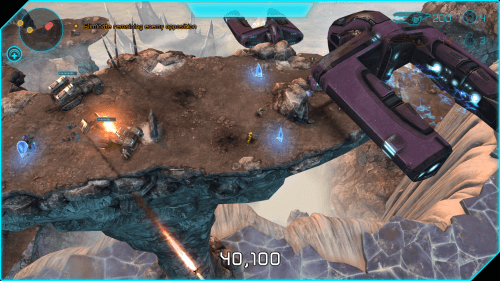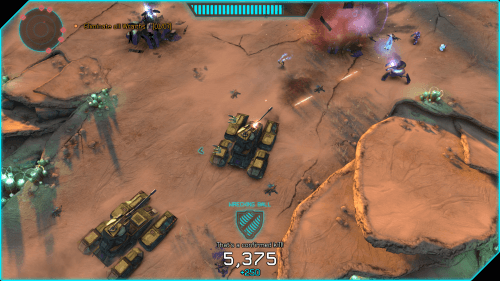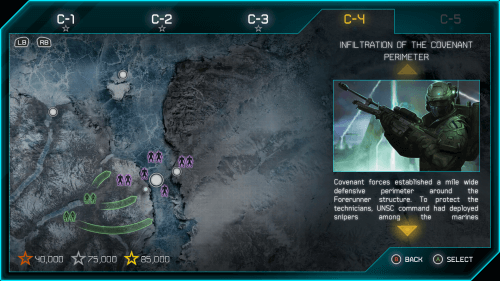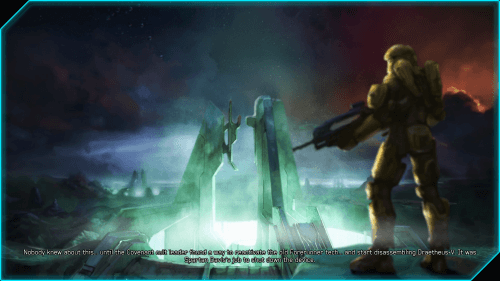The Story So Far: 6 months after the Didact was defeated the UNSC Infinity embarks on a mission to return to the Forerunner Shield World Requiem and reclaim it from Jul’Mdama’s rogue Covenant faction. As part of a massive combined force, including over 300 SPARTAN-IVs led by Commander Sarah Palmer, Spartan fireteams engage in various operations on Requiem’s surface. During one such mission, fireteam Crimson recovers a mysterious Forerunner artifact. Later investigating it aboard the Infinity, head engineer Dr. Glassman appears to be disintegrated by the artifact. In his absence, Dr. Catherine Halsey is temporarily released from custody after being arrested for war crimes, including her role in the SPARTAN-II program, and brought onboard to continue the investigation. During her research, Dr. Halsey begins communicating with an unknown entity who she eventually pieces together is Jul’Mdama himself. Caught in the act, Halsey is placed back into custody though not before reaching out to Jul’Mdama to offer her assistance with unlocking the Librarian’s AI imprint. As a result, combined Covenant and Promethean forces lay siege to the Infinity, appearing to abduct Dr. Halsey in the process. Brought to the Librarian’s shrine, Halsey is able to unlock and enter it before Jul’Mdama can intervene. ONI learns of Halsey’s betrayal and orders her assassination with Commander Palmer departing to handle it personally. Captain Lasky orders fireteam Majestic, who are already on Requiem, to rescue the doctor instead. The Librarian shows Halsey another artifact called the Janus Key, which can provide the real time location of all Forerunner technology, and gives it to her in hopes that it can be used to propel humanity’s evolution forward. Pulling her out of the shrine, Jul’Mdama snatches one half of the Janus Key from her just as Palmer and fireteam Majestic arrive. In the ensuing chaos Halsey passes the other half of the Janus Key to Majestic, Palmer wounds her, and Jul’Mdama absconds with her. As his fleet begins to jump away, Jul’Mdama deactivates the slipspace anchors holding Requiem in place, pulling it into a nearby sun. The Infinity is able to free itself from the artifact’s hold and jump away just in time.
With 343 Industries continuing to grow Halo as a full “transmedia” franchise, more of the type of spinoffs Microsoft first tried with Halo Wars seemed inevitable. Unlike Halo Wars though, 2013’s Halo: Spartan Assault wouldn’t be limited to a niche genre on a single platform; Spartan Assault was an easy to pick up and play twin stick shooter that was eventually available for Windows and iOS mobile devices, Xbox One and Xbox 360, and Windows. I’m not sure whether Spartan Assault’s sales actually reflected being both more approachable and more available but, given that it was quickly followed up with a sequel the following year, it seems likely.

“While the gameplay is a little repetitive there’s plenty of variety in the maps.”
I can’t say I have any particular fondness for twin stick shooters myself but these kinds of genre spinoff games are always intriguing to me. Still, never much of a mobile gamer, Spartan Assault flew completely under my radar and I honestly didn’t know that it was released on anything other than mobile devices until spotting it in the Xbox Store just a few years ago. Indeed, it’s that version I played for this playthrough; the Xbox One version on my Series X. Notably, this also marks the first time I’ll be covering something entirely new to me as part of Halo Fest 2020 and that remains the case from here on out. Kind of weird given how rooted in nostalgia this whole thing is, eh?
Spartan Assault actually does a fairly good job at taking a great deal of the core Halo formula and cramming it into a twin stick shooter mold. You play as a single Spartan wandering around on foot spraying down Covenant forces en masse with a variety of weapons. Included are staples like your Mjolnir armor’s recharging shield and a two weapon limit, with many of Halo’s iconic weapons showing up, and even armor abilities making a prominent appearance. One of the bigger twists to the genre is the lack of unlimited ammo, though scavenging from weapon racks, ammo crates, and fallen enemies should keep that from ever being more than a minor inconvenience. You’re sometimes given a UNSC Scorpion or Grizzly tank (though oddly no Warthogs) and hijacking Ghosts and Wraiths is an option as well. Overall, it all feels sufficiently “Halo”.

“Everything is better with tanks!”
Developed as a mobile game first, each mission takes no more than 10 or 15 minutes to complete, with many clocking in closer to 5 minutes. Between that and the lack of anything more than simple objectives like “destroy this emplacement” or “hold this point” there really isn’t a ton of challenge here. While there is a stripped down but otherwise familiar skull system, there isn’t any kind of selectable difficulty level either. Instead, the challenge is in earning a star rating based on your score at the end of each mission. In most missions earning a bronze star is effortless, though you’ll need to intentionally chase as many kill streaks and multikills as possible to get beyond that. The other way of doing this is via in-app microtransactions in the form of score boosts and temporary special weapon unlocks. Thankfully, these microtransactions (and indeed chasing high scores in the first place) can be easily ignored if you prefer, and purchasable with in-game experience points if you’re desperate to use them without laying down cash for the privilege.
Graphically Spartan Assault doesn’t come close to representing what the Xbox One can do. While serviceable, I’d argue that the Halo game it shares the most in common with, Halo Wars, shows a much higher degree of polish. The soundtrack fares better, with the original Halo trilogy’s soundtrack being an obvious influence. It’s just a shame you don’t get to hear more of it. A bigger complaint I have is that certain button assignments and other UI choices make it obvious that the controls definitely don’t appear to have been designed from the ground up with a gamepad in mind. That’s not to say they’re horrible, but they never clicked with me in a truly satisfying way which is kind of make or break for a twin stick shooter in my opinion. I also find it shocking that, despite being a common feature of both the Halo series and this entire genre, the campaign completely lacks cooperative play. There was a mini cooperative-only campaign that introduced a Firefight-like wave defense mode against our old friends the Flood added to the console releases, but even that lacks local co-op. Definitely a huge missed opportunity.

“The dryness of the mission briefings makes sense in context.”
Taking place sometime before the Infinity returned to Earth after the end of the Requiem Campaign (as described above) Spartan Assault is framed around a TACSIM training simulator that lets Spartans experience historical battles. The campaign covers the events of the Battle of Draetheus V, and follows the exploits of SPARTAN-IVs Edward Davis and Sarah Palmer. A motion comic style cutscene (similar to some of the ones we’ve seen in the terminals of earlier games) narrated by the Infinity’s quirky AI Roland sets up each operation, while each mission therein is presented by a strategic map and a couple of paragraphs of text that dryly describe each scenario.
Given that this is a side story that actually takes place out of chronological order, I’ll go over the plot here. While I’m fairly vague in these summaries they do still contain spoilers, so skip the next paragraph if you want to avoid them.
The Story: A splinter fleet of Covenant forces led by Sangheili Merg Vol appeared over the research colony of Draetheus V and launched an assault on its moon, X50. Spartans Edward Davis and Sarah Palmer rallied the UNSC defense, fortifying its primary research facility as well as setting up anti-air defenses to target incoming Covenant dropships. While successful in slowing the attack, Meg Vol’s fanatical forces still quickly overwhelmed them and established a solid foothold on X50. Spartan Palmer departed for Draetheus V to assist with its defense which soon escalated to targeted strikes against Covenant officers and an organized counter offensive resulting in a large armor engagement in which both sides suffered great losses. Meanwhile Meg Vol’s true goal became clear as it was discovered that X50 was not a natural moon but a massive Forerunner structure capable of building and destroying entire planets. With the support of the UNSC Eminent Domain and its marines, Spartan Davis was able to fight through the Covenant’s lines to the Forerunner control structure. UNSC technicians successfully disabled the weapon, though not before Merg Vol had already begun to unleash its devastating power against Draetheus V itself. Back on Draetheus V, Spartan Palmer’s efforts shifted to assisting with the evacuation of the planet, commandeering numerous Covenant troop carriers. With Meg Vol still at large on X50 and not being able to contact Davis who had been killed in action in a ferocious Covenant counterattack, Palmer headed back to X50 to hunt for the rogue Covenant leader. After a vicious battle, Palmer subdued and killed Vol. With his faction now leaderless and in retreat, the survivors were able to evacuate the system.

“He’s no Master Chief, but Spartan Davis did save an entire planet.”
Spartan Assault’s plot retreads a lot of familiar ground, especially on the heels of playing through Halo 4 and its Spartan Ops campaign. I can’t say it adds very much either; I’d personally hoped to learn a little more about Sarah Palmer given that she was already an established character but, as was increasingly the trend, 343 saved that for elsewhere. Still, the details of Palmer’s heroics during the battle of Draetheus V are certainly impressive and surely contributed to how she ended up as the Commander of Spartan Operations on the Infinity. Overall, while not all that significant to Halo’s overarching plot, the story of the Battle of Draetheus V at least doesn’t feel out of place in the canon.
In the end, Spartan Assault feels like a fairly typical budget spinoff game. It’s decently executed and relatively fun to pass the time with, but ultimately a fairly mediocre experience for anyone who isn’t a big fan of the twin stick shooter genre (who I’d imagine would have a heap of their own criticisms beyond the ones I brought up.) Still, as a unique experience within the franchise that’s quite quick to play through, it was an enjoyable enough diversion. I wouldn’t say you should avoid it, but it’s entirely skippable.